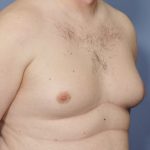As October is Breast Awareness Month, it is important to realize that men, like women, can develop breast cancer. Men just like women have breast tissue that can develop abnormal cancerous cells. But by comparison to women where about 500,000 new cases of breast cancer are diagnosed a year, the number of male cases is around 2,000 for about a 250:1 female/male occurrence ratio. This much lower incidence in men is due to a variety of reasons including the smaller amount of breast tissue that men have and the hormonal differences. As men age and their testosterone levels drop, the risk increases. This is most likely why breast cancer is most common in men between the ages of 60 and 70.
While male breast cancer may be less common than other male cancers, the death rate is significantly higher than for other typical male breast cancers such as prostate and testicular cancer. Whether this is because the breast tumor is more aggressive is speculative but late diagnosis is likely a contributing cause. There is a generalized lack of awareness of male breast cancer. As a result, men often mistake palpable or visible lumps for other problems and ignore them until the tumor is more advanced. This would also explain the higher mortality rate of near 30 % compared to 20% in women.
Risk factors for male breast cancer are numerous and include aging, family history of breast cancer, obesity, liver disease, alcoholism, estrogen drug treatment, radiation exposure, and certain genetic conditions such as Klinefelter’s syndrome and inherited gene mutations. Although these risk factors may increase a man’s chances of developing breast cancer, the cause of most breast cancers in men is still largely unknown. Suggestions for prevention have included keeping one’s weight down to as ideal as possible and limiting alcohol use. But there is no guaranteed way to prevent its occurrence.

Presently the best strategies for reducing the number of deaths caused by male breast cancer is early detection and prompt treatment. As previously noted, the concept of early detection has been a problem for men who tend to ignore breast lumps and see a physician only when it has gotten quite large.
Barry L. Eppley, M.D., D.M.D.
Indianapolis, Indiana


